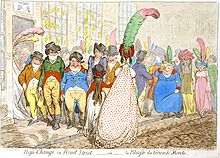JASNA AGM 2016
A Trip to JASNA AGM 2016 : Pre-Conference Part IV
Thursday Oct. 20
I made it to the hotel late morning for a workshop on no-sew turbans and bandeaus.
"Anne Mitchell had tried to put on a turban like mine, as I wore it the week before at the concert, but made wretched work of it — it happened to become my odd face, I believe, at least Tilney told me so at the time, and said every eye was upon me; but he is the last man whose word I would take." ~Isabella Thorpe
Turbans and turban-like headdresses were popular with European women throughout Jane Austen's lifetime. Women always covered their head with either white linen or muslin caps which were embroidered and ornamented with lace; straw, velvet or silk; hair ornaments like ribbons, flowers and combs; turbans of silk or cotton or a decorative hair wrap.
"Tuesday, 8 January 1799: I am not to wear my white satin cap tonight,
after all; I am to wear a mamalone [mameluke] cap instead, which Charles Fowle sent
to Mary, and which she lends me. It is all the fashion now; worn at the opera, and by Lady
Mildmays at Hackwood balls. I hate describing such things, and I dare say you will be able
to guess what it is like." Jane Austen to Cassandra Tuesday, 8 January 1799
Turbans were inspired by Turkish fashion but in Europe, they did not have a religious connotation. Fashion magazines began showing turban-like wraps in the 1780s. They were originally made from a silk scarf with fringed ends and also of crepe and silk. Toques (a small hat without a brim or with a narrow brim) of muslin, gauze or tulle fashioned over a wire frame were also popular. Women decorated their turbans with ribbons, feathers and jewels.
By the 1790s, turbans were made in a wrap style. Since these were not religious turbans, it was fashionable to show some hair peeking out and down below the turban. Some ladies wrapped their turbans leaving an end hanging over the
shoulder, while others added an additional bandeau. The top could be covered and women would attach ostrich plumes or brightly colored feathers with a hat pin. At this time the fashion was for the feather to stick straight up.
The popular cartoonist Gillray lampooned the fashion.
In the early 19th century, the fashion for headdresses became more diverse. The Oriental style was in as was the pillbox style, which was a little more hat-like than a turban. The saque style was inspired by caps worn by French Revolutionaries. The fashion for decorations changed frequently from ostrich plumes to brightly colored feathers to egret feathers. Turbans of this period were ornamented with fringe, pearls, pins and tassels. It was not unheard of to wear pearls with a turban! Fixed turbans also became popular in this period.
We saw an example of a homemade 19th century fixed turban one of the presenters made.
Fashions became more extreme after Jane Austen's death. In the 1820s exaggerated hairstyles, hats and turbans were all the rage.
The presenter also gave us a tutorial on how to get the Regency turban look cheaply. She purchased several gauze scarves at the local hardware store in various colors for only a few dollars. She also went shopping at Macy's after-Christmas sale and picked up an infinity scarf. She demonstrated various ways to tie a turban and we each chose a scarf, a feather and some hat pins. We spent some time practicing in front of a mirror.
The woman in front of me had long, straight hair wore loose under her turban. That reminded me a little too much of Captain Jack Sparrow so I resolved to curl my straight hair or hide it all under a turban. I tied a turban with my hair tucked under and thought that made me look too much like Professor Quirrell. Scary! Then I decided I really would curl my hair! A couple more tries with more hair sticking out made me look a little more Regency than Hogwarts. I went with long curls peeking partially out of a wrap style turban that had tails hanging down.
 |
| My turban after the ball... you get the general idea. |
Learn more about Regency turbans :



















No comments:
Post a Comment
Leave comments and or suggestions for QNPoohBear, the modern bluestocking.